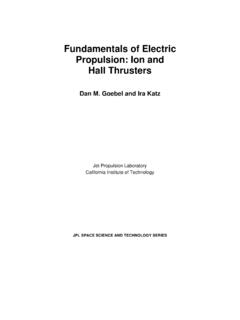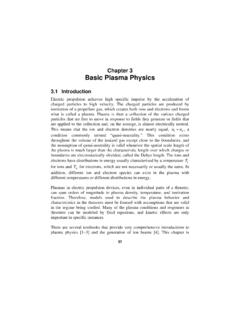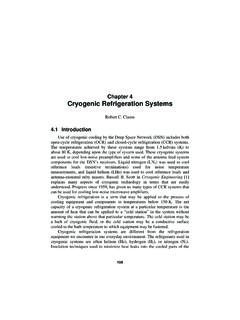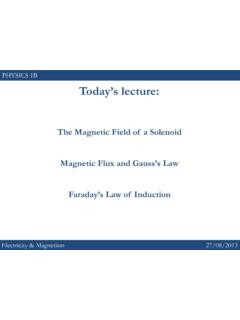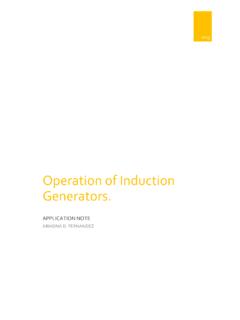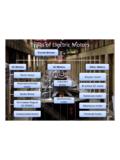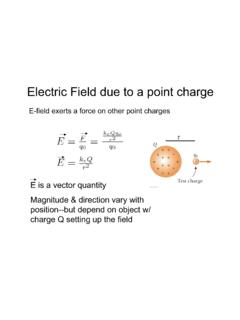Transcription of Chapter 3 Spacecraft Design Guidelines - NASA
1 31 Chapter 3 Spacecraft Design Guidelines Section describes processes involved in immunizing a Spacecraft against Spacecraft charging problems. Section lists Design Guidelines . If the reader wishes to make a requirements document, the basic requirements include: a. Determine whether or not the mission passes through or stays in regions with a charging threat. b. If in a charging threat region, determine the threat that is applicable to that environment. c. Implement measures to mitigate the threat to an acceptable level. Sections (General ESD Design Guidelines ), (Surface ESD Design Guidelines , Excluding Solar Arrays), (Internal ESD Design Guidelines ), (Solar Array ESD Design Guidelines ), and (Special Situations ESD Design Guidelines ) can be used as aids.
2 Processes The system developer should demonstrate through Design practices, test, and analysis that Spacecraft charging effects will not cause a failure to meet mission objectives. This section briefly discusses those processes. Introduction The classic approach to avoiding or eliminating electromagnetic problems is to look at the source of the problem, the victim, and the coupling between them. In the case of space charging, excess electrons deposit on surface or external Spacecraft areas or penetrate directly to victim circuit areas, the charge being 32 Chapter 3 buried in a circuit board immediately adjacent to the victim.
3 As a result, the three elements (source, coupling, and victim) are not always clearly distinguishable. For that reason, this book has disregarded these categories; however, this approach may sometimes be fruitful and is described below for completeness. Source The basic source of in-space charging problems is the charged particle environment (CPE). If that environment cannot be avoided, the next sources of ESD threats are items that can store and accumulate charge and/or energy. Ungrounded (isolated) metals are hazardous because they can accumulate charge and energy. Excellent dielectrics can accumulate charge and energy as well.
4 Limiting the charge storing material or charging capacity is a useful method for reducing the internal charging threat. This can be accomplished by providing a bleed path so that all plasma-caused charges can equalize throughout the Spacecraft or by having only small quantities of charge-storing materials. Coupling Coupling energy from a source via a spark (ESD) is very configuration-dependent and a function of the radiated and directly coupled signals. An ESD can occur in a variety of ways, such as from metal-to-metal, metal-to-space, metal-to-dielectric, dielectric-to-dielectric, dielectric breakdown, etc. The configuration of the charges determines the type of breakdown and hence the form of coupling.
5 An isolated conductor can discharge directly into an IC lead causing serious physical damage at the site, or the arc can induce an attenuated signal into a nearby wire causing little damage but inducing a spurious signal. As these examples illustrate, the coupling must thus be estimated uniquely for each situation. Eliminating coupling paths from a spark source to a victim will significantly lower the ESD threat. Coupling paths could be eliminated by separation, shielding, or filtering. Victim A victim is any part, component, subsystem, or element of a Spacecraft that can be adversely affected by an arc discharge (or field effects, in the case of some science instruments).
6 Given the different effects of ESDs, the types and forms of victims can be highly variable. ESD and electromagnetic compatibility (EMC)-induced parts failures, while major problems, are not the only ones. Effects can range from the so-called soft errors; , a memory element may be reset, to actual mechanical damage where an arc physically destroys material. Thus, the victims can range from individual parts to whole systems, from electronic components to optical parts. (Discharging in glass has long been Spacecraft Design Guidelines 33 known to cause fracturing and damage to optical windows or dielectrics, but empirical data suggests that optical lenses have apparently had a largely successful usage in space.)
7 The major victims and Design sources will be either individual electronic components or cables that can couple the transient voltage into a subsystem. Shielding or filtering at the victim will limit the adverse effects of ESDs. Design The designer should be aware of Design Guidelines to avoid surface and internal charging problems (Sections and ). All Guidelines should be considered in the Spacecraft Design and applied appropriately to the given mission. Analysis Analysis should be used to evaluate a Design for charging in the specified orbital environment. There are two major approaches to such analysis: a simple analysis and a detailed analysis, perhaps with a computer code.
8 A very simple analysis of internal electrostatic charging is illustrated in Appendix D. Several appropriate computer transport codes are listed in Appendix An example of a simple surface charging analysis is described in Appendix G. Test and Measurement Testing usually ranks high among the choices to verify and validate the survivability of Spacecraft hardware in a given environment. For Spacecraft charging environments, it is difficult to replicate the actual energetic plasma and total threat in all respects. The real electron environment can envelop the whole of the Spacecraft and has a spectrum of energies. There is no test facility that can replicate all the features of that environment.
9 As a consequence, verification and validation of charging protection are done with lower level hardware tests and with less realistic test environments. This does not reduce the value of the tests, but additional analyses must be done to provide Design validation where testing alone is inadequate. Several tests that can be performed to validate different aspects of charging are briefly described below. Material Testing Material electrical properties should be known before they are used. The key material properties needed are the ability to accumulate charge, , resistivity or conductivity, and the pulse threat, , stored voltage, energy.
10 Secondary but important parameters include resistivity changes with time in space, temperature (cold is more resistive), and, to a lesser extent, radiation-induced and E-fi eld-induced conductivity. Other properties are secondary electron 34 Chapter 3 emission, backscatter emission, and photoelectron emission properties. Surface contamination of materials in space also changes their charging behavior. Information about these parameters can be obtained from reference texts or by electron beam tests or conventional electrical tests. (Section contains a sample dielectric materials list.) Analysis or tests can be used to determine the threat for particular sizes and shapes of these materials.
